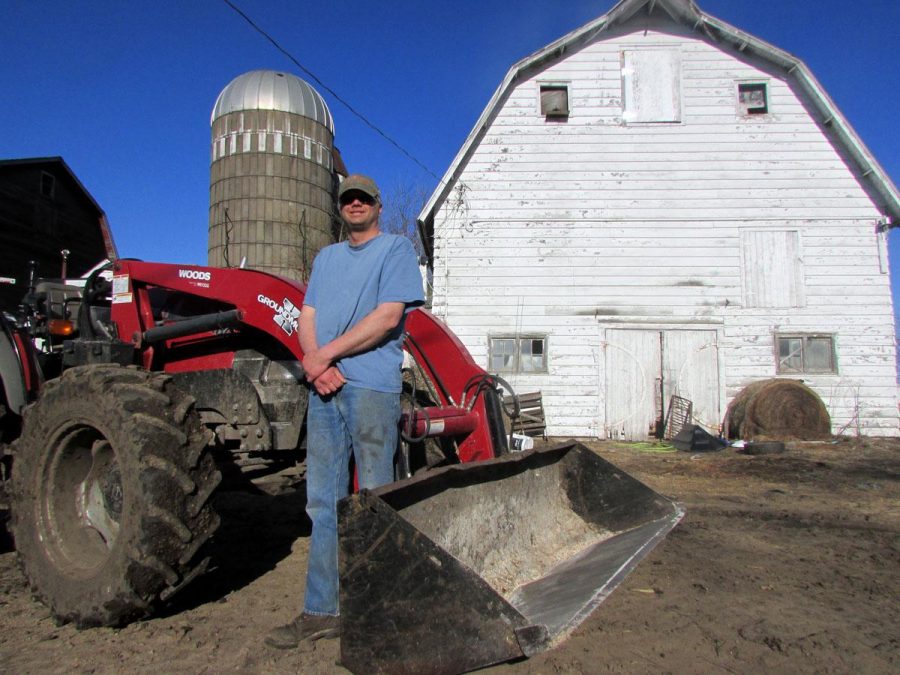Volkert devotes life to family farm
Senior Paul Volkert stadns proudly in fornt of his family barn. If I left my farm for more than one or two days, complete chaos would break loose in that barn!” Paul preached. “Every day, the cattle have to be fed and the electric fence has to be maintained so they don’t get out of the pasture.”
May 7, 2014
Where Minnesota and Wisconsin kiss each other on the Hudson Bridge, there lies a big white barn and a hackneyed house on the top of the hill that drivers have to struggle up while heading West into Minnesota. Out of the house comes a blue-collared, Carhartt-covered man who makes his daily rounds between the chicken coup and the cow barn. People whiz by on the freeway. Kids who play soccer and baseball at the Lucy Winton Bell Athletic Complex have to squint to see the tiny figure. What is being looked over in that barn is something so simple, so fundamental to their lives that they would cease to exist without what is in that barn. Paul Volkert takes care of those animals with all he has in his possession. His farm revolves around those animals that live in that big white barn.
42 year old Paul Volkert lives on a family farm with his mom, Mary Lou Volkert, and their dog Pal. Paul has lived there his whole life just as his parents, Ed and Mary Lou Volkert, and his grandparents, Ted and Frida Volkert, did. The farm has approximately 210 farmable acres where corn and soybeans are grown. As a side note, their main focus now is their beef cows.
After graduating from Stillwater Area High School in 1991, Paul decided to keep the family farm tradition alive by making that his livelihood. Up until 2005, Paul raised dairy cattle alongside his beef cattle and chickens; he then switched over to raising only beef cattle. Paul keeps a steady 25 head of Holstein beef cattle on the farm at all times.
“Going out to the barn and milking all the cows every day and every night just got to be too much for me,” Paul explained. “I wanted to start getting more involved with the beef cattle.”
On Paul’s family farm, raising beef cattle is a job that requires attention virtually around the clock. The average weight of a healthy Holstein cow is about 1.5 thousand pounds. To keep this weight, each cow must consume 50 pounds of feed a day.
“If I left my farm for more than one or two days, complete chaos would break loose in that barn!” Paul preached. “Every day, the cattle have to be fed and the electric fence has to be maintained so they don’t get out of the pasture.”
In the laborious job of tending to beef cattle, Paul knows that things can “head South” in a real hurry, and cost him a lot of time that is not there and money that should not be spent there. Paul has experienced many mishaps over the years of working on the farm.
“Last fall, I was loading some of our cows into our hauling trailer when out of nowhere a female got frightened and ran away,” Paul tentatively said. “We had to call the sheriff to get help locating the cow after hours of searching.”
Not all of Paul’s on-the-spot experiences have been bad, though. On an average day in the fall of 2003, Paul and his father Ed had heard strange noises coming from the big white barn. The strange noises were not bad signs to their ears; they had been anxious to hear these noises for quite some time. A female had been bred nine months before this.
“There is such a feeling of watching and helping a cow that you have watched grow and mature give birth to a healthy calf,” Paul boasted. “There is not one thing like it in the world.”
All in all, Paul is devoted to his farm day in and day out. He is not the only one who enjoys the raising cattle on a family farm: he is just one of 790 thousand family cattle ranchers in America today. Not one of those farmers has a story just like Paul’s; he is the king of what goes on in the big white barn along the freeway where Minnesota kisses Wisconsin on the Hudson Bridge.








Sydney Kuball • Jun 2, 2014 at 12:44 am
Really well done article, Your lead was very interesting and well written. It lead nicely into the story and definitely kept you reading. You really did your research and provided a lot of significant information. Nice job!
Emily Lodahl • Jun 1, 2014 at 7:40 pm
The lead paragraph was really strong and I liked how you made it descriptive so you can picture what the farm looks like. You have good quotes and it is an overall great article. Good job!
Travis Johnson • Jun 1, 2014 at 4:10 pm
Nice job Ross. As Paul mentioned above, there’s a few spelling errors, but they do not take away from the article. This article is very well written and a good read. I guess it’s in the Star Tribune for a reason!
Paul Hudachek • May 27, 2014 at 4:45 pm
Ross, this is a great article, especially considering there isn’t a strong news peg associated with this one. I also really appreciate the picture that is associated with the article, it applies well and gives us a proper visual to the article we are reading. The caption, though, could use a little refinement. I’m not sure why Paul Volkert is a “senior,” and “stadns” is a pretty blatant misspelling. Good job, though, Ross!